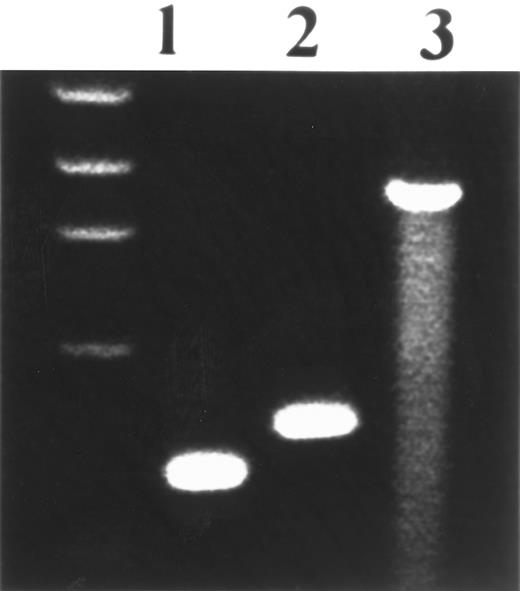To the Editor:
In the vast majority of patients diagnosed as having chronic myelogenous leukemia (CML) and t(9; 22), the breakpoint on chromosome 22 occurs in the M-BCR region of the BCR gene; this translocation usually results in a hybrid BCR/ABL mRNA with a b2a2 and/or b3a2 junction, which encodes a p210 fusion protein proved to be involved in the mechanism that underlies the chronic phase of CML. In 1990, Saglio et al1 described the cases of 2 CML patients with a variant type of BCR/ABL junction; the BCR breakpoint in this type of rearrangement occurs downstream from M-BCR, between exons el9 and e20 (originally named exons c3 and c4), a region that has been referred to as μ-BCR. This novel translocation results in the transcription of el9a2 type BCR/ABL fusion mRNA, which is translated into a novel 230-kD BCR/ABL protein.2 To date, this new el9a2 rearrangement has been reported in only a few patients,1-6 most of whom seem to present neutrophilic CML (CML-N), a rare myeloproliferative syndrome that is clinically more benign than typical CML; other cases were initially classified as essential thrombocythemia. We report a patient diagnosed as having typical CML in which an el9a2 type BCR/ABL rearrangement was detected.
A 29-year-old woman was first seen at our institution in March 1997. Five years earlier, she had presented with giant splenomegaly, thrombocytosis (689 × 109/L), and leukocytosis (white blood cell count [WBC] 203 × 109/L), and she was diagnosed as having CML. She was initially treated with busulphan for 4 months and later with interferon-α for 7 months, which achieved a hematologic response. She decided to discontinue all therapy, remaining stable until November 1995, when progressive leukocytosis and splenomegaly started. In March 1997, a physical examination showed giant splenomegaly; the peripheral blood count showed WBC 570 × 109/L (28% segments, 39% band cells, 9% metamyelocytes, 14% myelocytes, 2% blasts, 2% basophils, 1% eosinophils, and 5% monocytes), a hemoglobin level of 11 g/dL, and a platelet count of 609 × 109/L. Serum lactate dehydrogenase was 430 IU/L. The bone marrow was markedly hypercellular with extreme granulopoiesis. Cytogenetic analysis could not be performed because of the absence of mitosis. Southern blot analysis of the M-BCR region, using Bgl II, HindIII, and EcoRI restriction enzyme digestion, failed to show rearranged bands. RT-PCR was performed as described,7 and agarose gel electrophoresis of the PCR product showed a single fragment that was about 550-bp longer than the b3a2 BCR/ABL chimeric transcript both in bone marrow and in peripheral blood (Fig 1). Sequencing of this product showed that it was the result of the fusion between BCR exon el9 and ABL exon 2 and that the junction was in-frame.
Agarose gel electrophoresis of RT-PCR–amplified BCR/ABL chimeric transcripts. Lane 3 corresponds to the reported patient; lanes 1 and 2 correspond to two control patients with CML bearing b2a2 and b3a2 junction, respectively. The patient's band, resulting from the fusion of BCR exon 19 and ABL exon 2, is 540 bases longer than that of the b3a2 junction.
Agarose gel electrophoresis of RT-PCR–amplified BCR/ABL chimeric transcripts. Lane 3 corresponds to the reported patient; lanes 1 and 2 correspond to two control patients with CML bearing b2a2 and b3a2 junction, respectively. The patient's band, resulting from the fusion of BCR exon 19 and ABL exon 2, is 540 bases longer than that of the b3a2 junction.
Pane et al3 suggested that, in contrast to p210, the larger p230 protein may result in lesser disruption of the normal process of granulocytic differentiation, leading to a disorder characterized by an apparently indolent or benign clinical course. However, it remains unclear whether CML patients with this variant form of BCR/ABL protein really do have a different clinical pattern. A review of nine previously reported cases in which this type of BCR/ABL junction was detected1-6 shows that the presentation was atypical when compared with that of the normal variant of CML (7 patients were more than 40 years old at diagnosis; 8 had mild or no detectable splenomegaly; the WBC was less than 50 × 109/L in 7 patients, and none had a WBC greater than 100 × 109/L). In contrast to most previously reported cases, our patient was a young person with giant splenomegaly and an extremely high WBC, which are typical findings of classical CML. Although further studies in larger series of cases are warranted to clarify whether there is a relationship between CML phenotype and el9a2 genotype, our patient shows that this type of junction can be associated with classical CML.
The el9/a2 junction was discovered because of a discrepancy between cytogenetic findings showing Ph+ and Southern blot results showing an absence of rearrangement of the M-BCR region.1,3 In some studies, RT-PCR analysis using the primers specific to M-BCR region rearrangement failed to show visible bands, and some investigators have used a primer matching a sequence of exon el9 of the BCR gene for amplification of the el9a2 junction.3 However, in our experience, diagnosis can be suspected on the basis of RT-PCR because of an atypical sized band using habitual primers for M-BCR/ABL rearrangement detection; this fragment is 540 bases longer than that of the b3a2 junction.


This feature is available to Subscribers Only
Sign In or Create an Account Close Modal